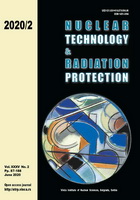
A TWENTY-YEAR RADIOCONTAMINATION STUDY OF EDIBLE FUNGI OF SERBIA
Activity Levels of 137Cs and Estimated Dose to the Population
Pages: 165-171
Authors: Ana A. Čučulović, Jelena N. Stanojković, and Dragan S. VeselinovićAbstract
Penny bun (Boletus edulis) and chanterelle (Cantharellus cibarius) are fungi used for human consumption in several forms: fresh, thermally treated, or conserved (salted, marinated, pasteurized, dried). Random samples were collected on the territory of the Republic of Serbia in the period 1999-2018 intended for export to the EU. The presence of 137Cs was noted in each individual fungi sample. The higher activity level of 137Cs in fresh penny bun samples was noted in 2001 (25.9 Bqkg-1), while in fresh chanterelle samples it was noted in 2000 (18.6 Bqkg-1). Marinating the fungi reduced activity levels of 137Cs in relation to the fresh fungi activity, for penny bun from 1.6 to 12.6 times for a year, while for chanterelle from 0.8 to 14.7 times for a year. Drying the fungi increases activity levels of 137Cs: for penny bun from 0.04 to 0.29 times for a year, while for chanterelle from 0.03 to 1.94 times for a year. The values of annual effective radiation doses were much lower than the recommended values for the population (1 mSv).
Key words: Boletus edulis, Cantharellus cibarius, 137Cs, annual effective dose
FULL PAPER IN PDF FORMAT (251 KB)
